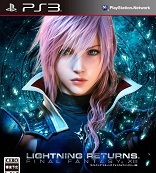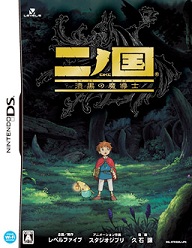Odin Sphere
PlayStation 2
Reviewed: 05/31/2007
 Even in the wake of three next-generation consoles, the PlayStation 2 is still holding its place in both the market and the TV screen. Even so, Odin Sphere, published in North America by Atlus, will probably be one of the PS2’s last RPGs, and is an appropriate end to the dynasty of a system known for sporting some of the best RPGs of this generation–pushing the console to, and sometimes beyond, its limit.Odin Sphere combines a twisting and engaging storyline with beat-’em-up action RPG gameplay. In doing so, it may have achieved what could be called the “perfect” story to gameplay ratio, in two different ways. The first is because Odin Sphere‘s involved story naturally balances well with the smallest amount of possible gameplay, so there is no need for “more” story. Players can always increase their gameplay, but Odin Sphere lets players tweak the ratio even further by making every cutscene skippable. Therefore, players who enjoy story-heavy RPGs are fine playing the game as is, and players who find the story to be fluff (they don’t know what they’re missing) can cut down on the story and immerse themselves in the action. Secondly, Odin Sphere‘s story to play ratio is consistent–two hours of play early in the game will award the same amount of plot as two hours in the middle–so players will never, for example, devote six or more hours of play and receive two lines of dialogue, unless they want to.
Even in the wake of three next-generation consoles, the PlayStation 2 is still holding its place in both the market and the TV screen. Even so, Odin Sphere, published in North America by Atlus, will probably be one of the PS2’s last RPGs, and is an appropriate end to the dynasty of a system known for sporting some of the best RPGs of this generation–pushing the console to, and sometimes beyond, its limit.Odin Sphere combines a twisting and engaging storyline with beat-’em-up action RPG gameplay. In doing so, it may have achieved what could be called the “perfect” story to gameplay ratio, in two different ways. The first is because Odin Sphere‘s involved story naturally balances well with the smallest amount of possible gameplay, so there is no need for “more” story. Players can always increase their gameplay, but Odin Sphere lets players tweak the ratio even further by making every cutscene skippable. Therefore, players who enjoy story-heavy RPGs are fine playing the game as is, and players who find the story to be fluff (they don’t know what they’re missing) can cut down on the story and immerse themselves in the action. Secondly, Odin Sphere‘s story to play ratio is consistent–two hours of play early in the game will award the same amount of plot as two hours in the middle–so players will never, for example, devote six or more hours of play and receive two lines of dialogue, unless they want to.
Odin Sphere‘s plot gives the game momentum. It highlights the struggle of five characters as officially they try to prevent an impending Armageddon. In actuality, the characters are mostly looking after their own interests. Rather than detract from the main plot, this creates a fascinating tale where the characters often wind up opposing each other. Each character must be completed in a specific order, and their stories take place over a timeline. The game lets one consult this timeline and view scenes, once passed, which is a nice touch, not to mention useful in following the path of minor characters and plot objects as they pass from character to character.
The plot delivery is aided by a strong script and voice acting. The option is open for players to select English or Japanese audio, but those who don’t need the Japanses comprehension practice should give the English voices a chance. The cheesiest voices were luckily given to bit-part NPCs and shopkeepers, and all of the main characters are well done, with obvious emotion and energy put into reciting the script.
 |
| Oswald mows down some Valkyries. Note the animated mini-map. |
Odin Sphere‘s story has a few downfalls. Scenes with two or more main characters in them will not be shown in the other characters’ viewpoints, in a first-come, first-served fashion. This is advantageous in avoiding making the player sit through what he’s already seen, but sometimes the connection between scenes is poor, and large gaps where already-seen scenes were removed can create confusion across storylines. As well, the story manages to generally avoid clichés, but can be a little over-poetic, especially considering four of the five main characters are romantically attached. Players who don’t enjoy professions of love or similar scenes might have difficulty enjoying choice plot points. The point to remember, though, is that this is a story about Armageddon, not about a specific character and their innermost emotional turmoil.
After the player is introduced to a given character’s story, said character is plunked down onto a circular battlefield, several of which make up an area map. Foes come in waves, and all must be defeated before any of the exits may be used. Several different kinds of attacks are available for each character, and all can chain regular blows together. The controls are simple, but luckily, Odin Sphere‘s combat doesn’t degrade into button mashing.
A power or ammunition bar depletes as players attack, and if it completely empties, the character is unable to attack and immobilized for a short time until it refills. As well, unless foes are knocked down, they can and will hit back even as they are hit, making it impossible to negotiate the character into a mob of enemies and merely hack away unscathed. Odin Sphere may not have a very large variety of enemies and bosses, but it has enough per location to keep things from getting dull, and some enemies and mini-bosses in particular require a lot of thought, strategy and hit-and-run tactics to beat.
 |
| You can cook meals in this game, but none of it looks quite like that succulent lobster in the foreground. |
In addition to the regular attacks, players can use items and potions via the Alchemy system in battle to deal damage, or Psypher skills. Alchemy materials can be combined with mandragora to create 26 different mixes. These can do everything from half received damage to cause fireballs, poison clouds or balls of ooze to attack the enemy. Psypher skills may be used when the characters’ weapons absorb purple lights, called Phozons, that are released when enemies are defeated or potions created. This energy can then be used to do damage, increase attack power, and so forth. Unfortunately, there aren’t very many Psypher skills available in Odin Sphere, and none are character-specific, so each character will acquire the exact same skills in a different order. Absorbing Phozons also provides experience to level up weapon strength, or they can be used to grow fruits from seeds. Eating fruit will both restore HP and provide experience points towards leveling up HP.
Overall, Odin Sphere‘s simplistic gameplay and combat system shows that action RPGs can be fun and challenging without being complicated. Minimizing character statistics helps to keep the game from getting mired in numbers and keeps it moving at a quick clip. Additionally, even though there are only two stats, characters grow at different rates, adding to the variety and strategy of playing between characters. The system has a few minor flaws, however. One such would be that the player’s score at the end of a level doesn’t seem to take certain circumstances into consideration, and another would be regarding item management. It’s impossible to combine two stacks of items, and a new menu must be brought up to rearrange item bags. Inventory space is limited and expensive, which is both fun and frustrating. Players with pack-rat approaches will need to quickly change their tune: the items are there to be used. Use them.
The largest downfall of Odin Sphere is that it gets repetitious. There are only eight locations, and each character will visit seven. Some bosses are fought by every single character. Battles with different characters add variety, but by the fourth and fifth time through, things start to drag. A few bosses are unique to certain characters, but for the most part it’ll be things that have been fought before. Fortunately, the endgame chapter is worth sticking through the last two characters to play through, for its incredible climax and five dynamic bosses.
It is in these final hours that Odin Sphere really shines. It is difficult to explain why without spoiling things, but the way that Odin Sphere‘s story culminates is phenominal. Considering how most of the game deals with the relationships between the characters, the way that the theme of tragedy, death and rebirth is explored is bold in its approach and frank in its delivery. In a genre where the ideas of life and death are all too often twisted for plot convenience, Odin Sphere takes a more untrodden path, to the benefit of the player. Also, those final boss battles are really cool.
 |
| Mercedes is the most modestly dressed of all the fairies. |
Odin Sphere gathered most of its hype from its pretty graphics. Packed with lushly colored, two-dimensional lineless sprites, this game is like the Everlasting Gobstopper of eye candy. The style of the sprites is unique to itself, and because it doesn’t follow a particular love-it-or-hate-it visual genre, such as anime-style, Odin Sphere‘s graphics don’t alienate players (except perhaps the color-blind ones). Furthermore, there are no graphical discrepancies or glitches, and when the game isn’t lagging, all the sprites animate smoothly and seamlessly.
Yes, that is to say, the game lags. Just like in the era of Super Nintendo, when players would struggle with too many enemies on the screen, Odin Sphere slows down when there is a lot going on on-screen, and sometimes when there isn’t. The lag isn’t game killing, but can be irritating at the best of times. One location in particular will frequently slow down, and that area’s boss fight will see the game running less than half speed.
Aurally, Odin Sphere is filled with catchy orchestrated music, which isn’t really an oxymoron. There isn’t a ton of music, but there is enough to maintain variety, and all are pleasant to listen to, especially the game’s main theme. Sound effects are not outstanding, but not at all unpleasant.
Odin Sphere has a story that’s complex enough to stand up to another playthrough, but there isn’t a lot of extra incentive to pick up the game once completed besides the adjustable difficulty. There isn’t anything to collect aside from recipes, and the game is linear and devoid of sidequests or minigames. The latter is probably a good thing, but even so, a reason to pick up the game again besides its own merits may have been welcome.
In the end, Odin Sphere proves itself to be a worthy RPG offering, packed with delights to the eye and ear, engaging combat and an impeccably delivered story. Despite its faults and the plague of lag, it carries its way throughout its duration with near-perfect pacing. Whatever one’s opinion of some aspects of Odin Sphere, it is a game that has been developed with obvious care and quality, and should be given at least a glance.
-Janelle Hindman
| Score Breakdown | ||
| Overall Great Out of 10 See our Review Criteria |
Gameplay | Very Good |
| Story | Great | |
| Graphics | Excellent | |
| Sound/Music | Very Good | |
| Replay Value | Bad | |
| The Verdict: Great | ||








